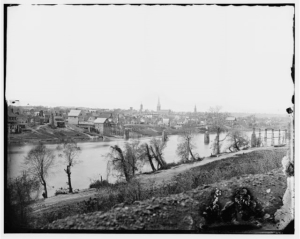“The Falmouth Canal and Its Mills”
“The Falmouth Canal and Its Mills”
“The Falmouth Canal and Its Mills: An Industrial History” is an article by John Janney Johnson that can be found in the second volume of the Journal of Fredericksburg History. It focuses on the seemingly forgotten industrial past of Fredericksburg and Falmouth, Virginia. Here is a summary of that article done by Erin Adams, an HFFI intern, for your enjoyment.
The portion of the Rappahannock River between Fredericksburg and Falmouth is characterized by an extremely powerful water flow that falls 22 feet within 1 mile. This made the area an appealing site for construction of hydro-powered mills on the river’s banks. Beginning as early as the 1720s, dams were constructed so that the Rappahannock water power could be harnessed to fuel the mills that had already begun operation.
Between 1775 and 1800, the Falmouth Canal was built, prompting construction of four more mills. Between the 1720s and the 1880s, numerous mills and warehouses with varying purposes (primarily grist, flour, and iron) were constructed and operated along the canal and river bank. The passage of time, however, has eroded any trace of these once-mighty industrial structures. Upriver, the canal and its stone retaining wall are still visible, but mostly washed out or covered by greenery, and the only building ruins that remain are at the site of the Rappahannock Forge.
For approximately 160 years these mills dominated the Fredericksburg waterfront, which might seem like a fairly short time in the grand scheme of things, but they helped establish Fredericksburg and Falmouth as an industrial hub. For example, in 1816, a total of 160,000 barrels of flour were exported through the Rappahannock ports, and during the 1820s-30s, the port was widely used by western farmers in the area. However, the development of railroad technology throughout the early to mid-19th century hurt the once thriving commerce of Falmouth and Fredericksburg.
Fredericksburg, Va. View of town from east bank of the Rappahannock, Library of Congress Prints and Photographs Division
Early in the Civil War, the mills saw an increase of business (especially the steam-powered Falmouth Cotton Factory), but once Fredericksburg and Falmouth were occupied by Union troops in March 1862, all of the mills were subsequently severely damaged or destroyed. Many of the businesses attempted to reassemble their mills and continue operation, but the amount of destruction, combined with the rise of the railroad and other technologies in exportation, prevented the recovery of the mills and warehouses.
These industries faced many challenges but provided economic stability to the region before disappearing from the shores of the Rappahannock. They left minimal information behind about their impact on the community.
The full text of “The Falmouth Canal and Its Mills: an Industrial History” is a much more in-depth look into these mills and factories, their purposes and impacts, and the people who owned them (who had their own personal trials and tribulations associated with their businesses). To learn more about Fredericksburg and Falmouth’s fascinating industrial mill past, please visit the HFFI and ask about the Journal of Fredericksburg History: Volume Two.


Leave a Reply
Want to join the discussion?Feel free to contribute!